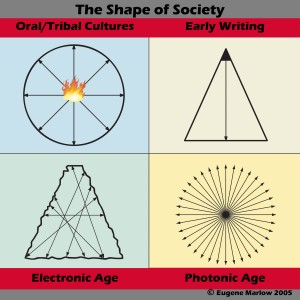Mankind’s communications technology history can be divided into four mega stages: oral communications; written, then printed communications; electronic communications; and most recently communications based on photonic technologies.
Oral Communications
The initial stage of man’s evolution as a communicating species is the age of oral communications. This age has lasted, of course, until the present day. All of our electronic and photonic devices notwithstanding, we still use orality to communicate. But it should not be taken for granted that orality has been extant since man’s antecedents walked out of Africa and began to populate the world. As Robbins Burling, author of The Talking Ape: How Language Evolved (Oxford University Press, 2005), points out, man’s development of language as a means of communication beyond body language and cries and calls probably took a period of a couple of million years to evolve, beginning with physiological changes to the position of the voicebox in relation to the tongue and mouth. In effect, language is a success story that did not happen overnight.
This age can be symbolized by a circle. Why? Because in the age of oral communication it all took place in a face-to-face context. In a tribal context, imagine the old man of the tribe sitting around the campfire in a circle telling the stories, the news of tribe. Everyone in earshot was at that moment part of the tribe. The record or history of the tribe was verbal. It radiated from the speaker. Everyone who was around to hear the speaker received the message directly from the storyteller. Hence the circular symbol.
The Age of Writing and Print
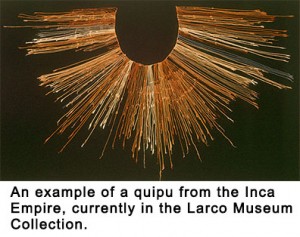 Tribal history and record keeping moved from the ear to the eyes with the development of visual symbols, for example, primeval Chinese ku-wan–gesture pictures. These pictures preceded pictographs, the picture symbols that first appeared in Western Asia. Native American tribes notched or painted sticks to convey messages. In South America, Incas knotted colored quipu cords to keep complex records. Notice that all these last approaches have an element of portability.
Tribal history and record keeping moved from the ear to the eyes with the development of visual symbols, for example, primeval Chinese ku-wan–gesture pictures. These pictures preceded pictographs, the picture symbols that first appeared in Western Asia. Native American tribes notched or painted sticks to convey messages. In South America, Incas knotted colored quipu cords to keep complex records. Notice that all these last approaches have an element of portability.
About 10,000 years ago, in 8,000 BC in Sumer in the so-called Fertile Crescent, particularly Mesopotamia, small clay triangles, spheres, cones and other tokens were molded to represent sheep, measures of grain, jars of oil and other trading goods. Around 3,100 BC the Sumerians invented numerals, thus separating the symbols for sheep from the number of sheep. This was perhaps the first digital (as opposed to analogic, as in orality) technology.
Fast forward a few millennia to somewhere between 1,100 and 800 B.C. when the Greeks added vowel sounds and both expanded and contracted the antecedent Phoenician alphabet to create the unique alphabet we use today. This alphabet became the standard for writing in the Western world. I use the word standard advisedly: standardization along with portability are the two central prerequisites for the ubiquitous adoption of a new technology.
Before there was printing, there was copying by hand. Before copying by hand, there was paper. The invention of paper in China is credited to a eunuch, Ts’ai Lun, the emperor’s minister of public works, in 105 A.D. .
In the eleventh century, one Pi Sheng, a [Chinese] blacksmith and alchemist, invented movable type, molding characters out of baked clay–pottery type that he placed in an iron frame. He made several copies of each word character and 20 or more of the most common words so he could print a whole page at once. Unfortunately, success eluded Pi Sheng. No ink behaved well with pottery type and the sheer volume of Chinese word characters (today there are about 40,000) worked against his medium of poetry type, so it was easier just to engrave wooden blocks.
It was printer Johnannes Gutenberg, in the mid-1400s, in Mainz, Germany, who produced a printing system using movable type. Most obvious among its elements were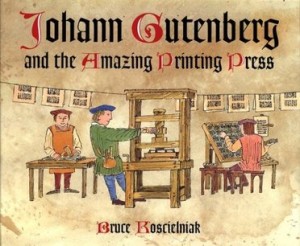 controlled, exact dimensions of alphabet type cast from metal punches made of hardened steel. These were not unlike the dies, stamps, and punches that were well known to European leather workers, metal-smiths, and pewter makers.
controlled, exact dimensions of alphabet type cast from metal punches made of hardened steel. These were not unlike the dies, stamps, and punches that were well known to European leather workers, metal-smiths, and pewter makers.
In 1451 Gutenberg used a press to print an old German poem. In 1453 he prints a 42-line per page Bible. By 1490 the printing of books on paper (rather than parchment) becomes more common in Europe. By 1500 approximately 35,000 books have been printed, some 10 million copies.
Note again that fundamental to the success of the printing press is the characteristic of standardization. The portability factor comes into play with respect to the product–the thousands of books that contained history, records, and ideas that could be easily transported from one place to another.
Writing and printing: lines on paper, read from left to right in Western cultures, right to left in Middle Eastern cultures, and down and up in Far Eastern cultures, paragraph by paragraph, page by page. Linear and orderly. From a communications model point of view, writing and printing evolved what has become known as a militaristic or bureaucratic model symbolized by a triangle, or, if you prefer, a pyramid.
Writing and printing evolved hierarchical societies: the top of the hierarchy (primarily those who could read and write) told the folks in the middle of the hierarchy what to do. They, in turn, told the rest of the society (primarily those who could not read and write) what to do.
This form of societal organization–militaristic, bureaucratic, industrial and manufacturing oriented–existed intact from the time of the great Pharaohs to the middle of the 20th century. The symbol of this kind of society–the pyramid–can be viewed as imposed on the circular symbol that represents the antecedent oral society.
The Electronic Age
The more recent communications technology stage is the electronic age, symbolized by an amoeba-like pyramid. Imagine this symbol superimposed on the top of the pyramid, on top of the circle. All three co-exist today.
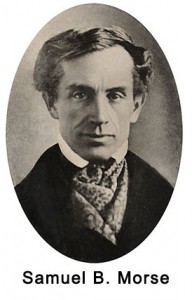 The electronic age was born in 1838–a mere 176 years ago. Early in that year Samuel Finley Breese Morse—artist, daguerrotypist, a so-called “American Leonardo”–gave a series of public demonstrations of the first practical electromagnetic telegraph. In 1844, after receiving a thirty-thousand dollar grant to construct a telegraph line between Baltimore and Washington D.C. the year before, Morse finally opened the nation’s first commercial telegraph line on May 24 with the now famous query “What hath God wrought?” On that day the electronic communications age was born. On that day, the message was separated from the messenger at the speed of light.
The electronic age was born in 1838–a mere 176 years ago. Early in that year Samuel Finley Breese Morse—artist, daguerrotypist, a so-called “American Leonardo”–gave a series of public demonstrations of the first practical electromagnetic telegraph. In 1844, after receiving a thirty-thousand dollar grant to construct a telegraph line between Baltimore and Washington D.C. the year before, Morse finally opened the nation’s first commercial telegraph line on May 24 with the now famous query “What hath God wrought?” On that day the electronic communications age was born. On that day, the message was separated from the messenger at the speed of light.
Then came Thomas Edison, himself a master telegrapher, also inventor of the electronic light bulb and many other electrical devices that have contributed to our speed of light culture. About the same time, the telephone was invented.
The basis for modern network broadcasting was created in the United States by the American Telephone & Telegraph Company (AT&T). In 1922, AT&T opened radio station WEAF in New York. Soon thereafter broadcast radio became a dominant mass medium in the United States with many people and families listening to the radio in groups to electronic reporters.
In 1939 at the World’s Fair in New York, broadcast television was introduced to the American public. At the time it was called “Radio with Pictures.” Soon broadcast television became the dominant mass medium, especially for news. In time, network television became the medium of choice for primetime.
But in the 1950s came cable television. And today several local and regional cable outlets have developed news channels, such as NY1 in New York City. Broadcast news channels have become just another number on the cable box.
In between these developments in radio and broadcast and cable television, 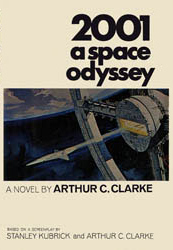 satellites were developed. Actually it was in the mid-1940s that Arthur C. Clark, the author of 2001 A Space Odyssey first proposed the idea. Satellites not only expanded the broadcast television world, and helped launch the pay cable network business, it also gave birth to business teleconferencing, which lead, in turn, to the advent of satellite media tours.
satellites were developed. Actually it was in the mid-1940s that Arthur C. Clark, the author of 2001 A Space Odyssey first proposed the idea. Satellites not only expanded the broadcast television world, and helped launch the pay cable network business, it also gave birth to business teleconferencing, which lead, in turn, to the advent of satellite media tours.
Computers, of course, and computer networks are the communications media of the 1990s-present. Even though the first mainframes were developed in the mid-1940s, today computers in the form of personal computers give new meaning to the phrase “information access.”
All of these electronic technologies are merging into what we call today the Internet and the World Wide Web.
In sum, between 1838 and now a cornucopia of electronic media have been created to reach a variety of audiences on a local, regional, national, and now global scale.
The Photonic Age
It should be obvious that the electronic age is not the end all, be all of man’s communication technology evolution. I propose we have already entered the next stage in the history of communications technology: the age of photonics, or the age of light.
What is photonics? Photonics is “The technology of generating and harnessing light and other forms of radiant energy whose quantum unit is the photon. 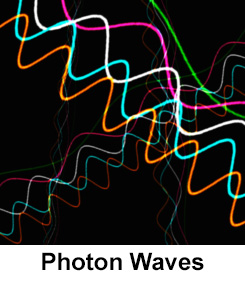 The range of applications of photonic extends from energy generation to detection to communications and information processing.”
The range of applications of photonic extends from energy generation to detection to communications and information processing.”
You are already familiar with some photonic devices: fiber optics for telecommunications, supermarket checkout scanners, CD-ROMs, lasers in medicine, lasers in military weaponry. Of course, in science fiction there are many more photonic applications: phasers and non-invasive surgery tools.
Apart from the fact that more and more technologies are increasingly using photonic applications, there are other clues that we are at the early stages of a new communications technology era.
It can be said that the work of artists are precursors to emerging trends. For me, the clue to the emergence of the age of light comes from Steven Spielberg’s “Close Encounters of the Third Kind.” When you watch this film one of the things that should become apparent is that it is all about light: shades of light, use and misuse of light, shedding light on the truth, lighting up the sky, reaching for the light, and the light within. |
It has become an accepted truth that nothing travels faster than the speed of light. Yet some films presage just the opposite. And keep in mind that one of the first movies ever made at the turn of the 20th century presaged a trip to the moon, almost 70 years before it actually happened!
All in all, it needs to be pointed out that while it took a couple of million years for man to communicate via spoken language, it has only taken about 12,000 years for the species to move from an agricultural-dominant culture, to writing, then printing, to electronic media, and now photonic communications media.
More on this subject in the next blog.
Please write to me at meiienterprises@aol.com if you have any comments on this or any other of my blogs.
Eugene Marlow, Ph.D.
September 15, 2014
© Eugene Marlow 2014


